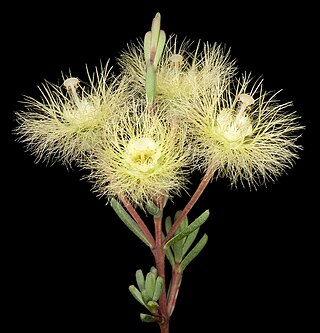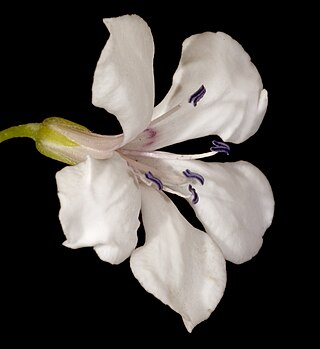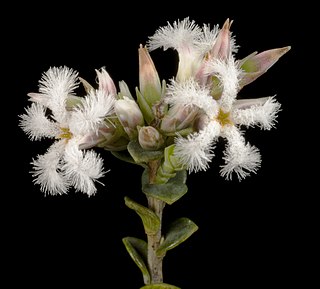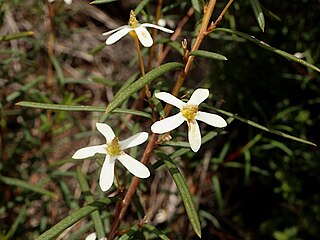
Eucalyptus rudis, commonly known as flooded gum or moitch, is a species of small to medium-sized tree endemic to coastal areas near Perth, Western Australia. The Noongar names for the tree are colaille, gooloorto, koolert and moitch. This tree has rough, fibrous bark on the trunk and large branches, smooth greyish bark above, lance-shaped to curved adult leaves, flower buds in groups of between seven and eleven, white flowers and bell-shaped, cup-shaped or hemispherical fruit.

Melaleuca huegelii, commonly known as chenille honey-myrtle, is a plant in the myrtle family, Myrtaceae and is endemic to the south-west coastal areas of Western Australia. It has small, almost scale-like leaves and flower spikes sometimes more than 100 millimetres (4 in) long on the ends many of its branches.

Verticordia huegelii, commonly known as variegated featherflower, is a flowering plant in the myrtle family, Myrtaceae and is endemic to the south-west of Western Australia. It is a sometimes an erect shrub, sometimes sprawling to almost prostrate. It has linear leaves and very feathery flowers in spring. The flowers are usually cream-coloured or white, becoming pinkish and reddish or maroon as the flowers age, giving a variegated appearance to the display.

Verticordia pennigera, commonly known as native tea, is a flowering plant in the myrtle family, Myrtaceae, and is endemic to the south-west of Western Australia. It is usually a small erect or prostrate shrub with small leaves and lightly-scented spikes of pale pink to magenta-coloured flowers in spring.

Eutaxia parvifolia is a species of flowering plant in the family Fabaceae and is endemic to southwestern Western Australia. It is a shrub with reddish brown stems, elliptic to egg-shaped leaves with the narrower end towards the base, and mostly yellow, red or orange flowers, with yellow red or orange markings.

Verticordia huegelii var. decumbens, commonly known as variegated featherflower, is a flowering plant in the myrtle family, Myrtaceae and is endemic to the south-west of Western Australia. It is an almost prostrate shrub, with creamish-lemon coloured flowers turning pink then red as they age, giving the plant a variegated appearance. It is similar to Verticordia huegelii var. huegelii but has a lignotuber and a lower growth habit.

Verticordia roei, commonly known as Roe's featherflower is a flowering plant in the myrtle family, Myrtaceae and is endemic to the south-west of Western Australia. It is a shrub with narrow leaves and is often covered with masses of creamy-white coloured flowers in late spring.

Verticordia tumida, commonly known as summer featherflower, is a flowering plant in the myrtle family, Myrtaceae and is endemic to the north-west of Western Australia. It is an open shrub with very small leaves and clusters of deep pink flowers from late spring to early winter.

Darwinia vestita, commonly known as pom-pom darwinia, is a species of flowering plant in the family Myrtaceae and is endemic to the southwest of Western Australia. It is an erect, bushy shrub with crowded egg-shaped, oblong, or linear leaves and more or less spherical heads of white to reddish-pink flowers.

Babingtonia camphorosmae, commonly known as camphor myrtle, is a species of flowering plant in the family Myrtaceae and is endemic to the southwest of Western Australia. It is a prostrate to low-growing shrub with linear to thread-like leaves and white or pink flowers in groups of up to five, each flower with ten to thirteen stamens.

Daviesia divaricata, commonly known as marno, is a species of flowering plant in the family Fabaceae and is endemic to the south-west of Western Australia. It is a low, spreading or erect and bushy shrub with phyllodes reduced to small, triangular scales, and orange and maroon flowers.

Boronia cymosa, commonly known as granite boronia, is a plant in the citrus family Rutaceae and is endemic to the south-west of Western Australia. It is an erect shrub with linear, more or less cylindrical leaves and groups of relatively small, pink four-petalled flowers arranged on branched flowering stems.

Marianthus candidus, commonly known as white marianthus, is a species of flowering plant in the family Pittosporaceae and is endemic to the south-west of Western Australia. It is a twining shrub or climber with elliptic leaves and white flowers arranged in groups of twenty to thirty and becoming fawn or pink as they age.

Philotheca linearis, commonly known as the rock wallaby shrub or narrow-leaf wax-flower, is a species of flowering plant in the family Rutaceae and is endemic to an inland areas of southern Australia. It is a shrub with glandular-warty branchlets and leaves, club-shaped to cylindrical leaves and white flowers arranged singly in leaf axils.

Kennedia carinata is a species of flowering plant in the family Fabaceae and is endemic to the south-west of Western Australia. It is a prostrate shrub with trifoliate leaves and reddish-purple, pea-like flowers.

Lechenaultia floribunda, commonly known as free-flowering leschenaultia, is a species of flowering plant in the family Goodeniaceae and is endemic to the south-west of Western Australia. It is an openly-branched shrub or subshrub with crowded, narrow, fleshy leaves and compact groups of pale blue to pale mauve or creamy white flowers.
Lasiopetalum cordifolium, is a species of flowering plant in the family Malvaceae and is endemic to the south-west of Western Australia. It is an erect shrub with hairy stems, heart-shaped leaves and pink, cream-coloured or white flowers.
Commersonia parviflora, commonly known as small flowered rulingia, is a species of flowering plant in the family Malvaceae and is endemic to the south of Western Australia. It is a low, prostrate or dense shrub with wrinkled, egg-shaped leaves with rounded teeth on the edges, and clusters of small, white flowers.

Leucopogon squarrosus is a species of flowering plant in the heath family Ericaceae and is endemic to the southwest of Western Australia. It is an erect shrub with hairy young branchlets, egg-shaped or elliptic leaves and dense, erect clusters of 5 to 14 white flowers on the ends of branches and in upper leaf axils.

Ricinocarpos glaucus is a species of flowering plant in the family Euphorbiaceae and is endemic to the south-west of Western Australia. It is an erect, monoecious or dioecious shrub with linear or narrowly oblong leaves and male and female flowers arranged singly or in small groups.



















